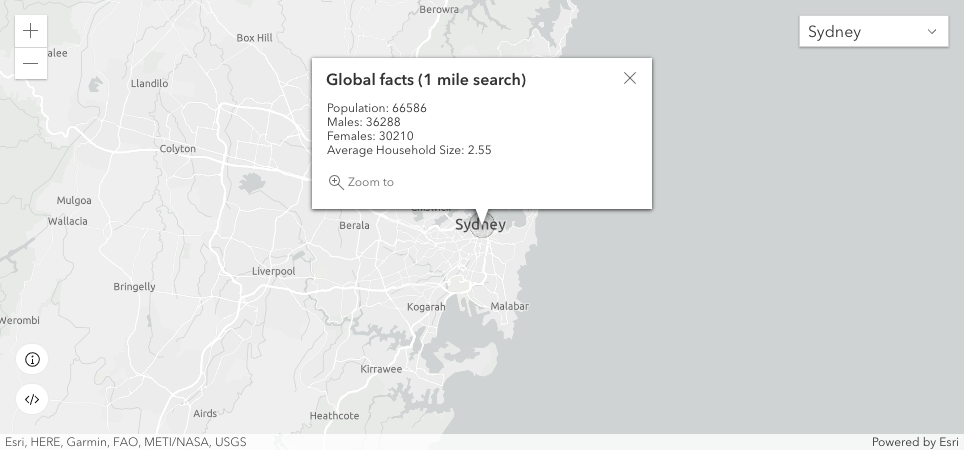GET geoenrich.arcgis.com/arcgis/rest/services/World/geoenrichmentserver/GeoEnrichment/enrich?StudyAreas=[{'geometry':{'x': -117.1956, 'y': 34.0572}}]&f=pjson&token=<ACCESS_TOKEN> HTTP/1.1GeoEnrichment service
The GeoEnrichment service finds demographic information and other location facts for places around the world. A point or polygon can be used to retrieve data associated with the location and surrounding area. The service provides over 15,000 data fields to choose from with coverage for more than 150 countries and regions.
Key features
- Demographic data enrichment coverage for many countries and regions.
- Supports study areas such as rings and drive times derived from point locations.
- Contains curated data collections of demographic analysis variables for areas.
- Supports a custom list of data fields from one or more data collections.
- Returns geometry and data for a study area that can be displayed on a map.
Tip:
To learn more about the GeoEnrichment service features and capabilities, go to GeoEnrichment in the Mapping APIs and location services guide.
Access the service
To access the service you need the following:
- An ArcGIS Developer account or ArcGIS Online account.
- An access token (API key or OAuth 2.0).
Tip:
To learn more about API keys and OAuth 2.0, see Security and authentication in the Mapping APIs and location services guide.
Example
This example shows how to find global facts for a location using enrich.
{
"results" : [ {
"paramName" : "GeoEnrichmentResult",
"dataType" : "GeoEnrichmentResult",
"value" : {
"version" : "2.0",
"FeatureSet" : [ {
"displayFieldName" : "",
"fieldAliases" : {
"ID" : "Id",
"OBJECTID" : "Object ID",
"sourceCountry" : "Country code",
"areaType" : "Area type",
"bufferUnits" : "Buffer units",
"bufferUnitsAlias" : "Buffer units alias",
"bufferRadii" : "Buffer radii",
"aggregationMethod" : "Aggregation method",
"populationToPolygonSizeRating" : "Population to polygon size rating for the country",
"apportionmentConfidence" : "Apportionment confidence for the country",
"HasData" : "Has data",
"TOTPOP" : "Total Population",
"TOTHH" : "Total Households",
"AVGHHSZ" : "Average Household Size",
"TOTMALES" : "Male Population",
"TOTFEMALES" : "Female Population"
},
"spatialReference" : {
"wkid" : 4326,
"latestWkid" : 4326
},
"fields" : [ {
"name" : "ID",
"alias" : "Id",
"type" : "esriFieldTypeString",
"length" : 256
}, {
"name" : "OBJECTID",
"alias" : "Object ID",
"type" : "esriFieldTypeOID"
}, {
"name" : "sourceCountry",
"alias" : "Country code",
"type" : "esriFieldTypeString",
"length" : 256
}, {
"name" : "areaType",
"alias" : "Area type",
"type" : "esriFieldTypeString",
"length" : 256
}, {
"name" : "bufferUnits",
"alias" : "Buffer units",
"type" : "esriFieldTypeString",
"length" : 256
}, {
"name" : "bufferUnitsAlias",
"alias" : "Buffer units alias",
"type" : "esriFieldTypeString",
"length" : 256
}, {
"name" : "bufferRadii",
"alias" : "Buffer radii",
"type" : "esriFieldTypeDouble"
}, {
"name" : "aggregationMethod",
"alias" : "Aggregation method",
"type" : "esriFieldTypeString",
"length" : 256
}, {
"name" : "populationToPolygonSizeRating",
"alias" : "Population to polygon size rating for the country",
"type" : "esriFieldTypeDouble"
}, {
"name" : "apportionmentConfidence",
"alias" : "Apportionment confidence for the country",
"type" : "esriFieldTypeDouble"
}, {
"name" : "HasData",
"alias" : "Has data",
"type" : "esriFieldTypeInteger"
}, {
"name" : "TOTPOP",
"alias" : "Total Population",
"type" : "esriFieldTypeDouble",
"fullName" : "KeyGlobalFacts.TOTPOP",
"component" : "demographics",
"decimals" : 0,
"units" : "count"
}, {
"name" : "TOTHH",
"alias" : "Total Households",
"type" : "esriFieldTypeDouble",
"fullName" : "KeyGlobalFacts.TOTHH",
"component" : "demographics",
"decimals" : 0,
"units" : "count"
}, {
"name" : "AVGHHSZ",
"alias" : "Average Household Size",
"type" : "esriFieldTypeDouble",
"fullName" : "KeyGlobalFacts.AVGHHSZ",
"component" : "scripts",
"decimals" : 2,
"units" : "count"
}, {
"name" : "TOTMALES",
"alias" : "Male Population",
"type" : "esriFieldTypeDouble",
"fullName" : "KeyGlobalFacts.TOTMALES",
"component" : "demographics",
"decimals" : 0,
"units" : "count"
}, {
"name" : "TOTFEMALES",
"alias" : "Female Population",
"type" : "esriFieldTypeDouble",
"fullName" : "KeyGlobalFacts.TOTFEMALES",
"component" : "demographics",
"decimals" : 0,
"units" : "count"
} ],
"features" : [ {
"attributes" : {
"ID" : "0",
"OBJECTID" : 1,
"sourceCountry" : "US",
"areaType" : "RingBuffer",
"bufferUnits" : "esriMiles",
"bufferUnitsAlias" : "Miles",
"bufferRadii" : 1,
"aggregationMethod" : "BlockApportionment:US.BlockGroups;PointsLayer:US.BlockPoints",
"populationToPolygonSizeRating" : 2.191,
"apportionmentConfidence" : 2.576,
"HasData" : 1,
"TOTPOP" : 12799,
"TOTHH" : 5158,
"AVGHHSZ" : 2.46,
"TOTMALES" : 6190,
"TOTFEMALES" : 6609
}
} ]
} ]
}
} ],
"messages" : [ ]
}
To see a live example, go to the Mapping APIs and location services guide.
Tip:
Learn how to access the GeoEnrichment service with different ArcGIS and open source APIs in the Mapping APIs and location services guide.